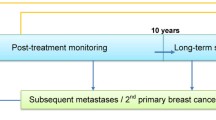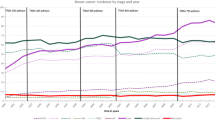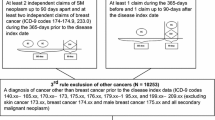Abstract
Purpose
To develop and validate a method for estimating numbers of people with distant cancer metastases, for evidence-based service planning.
Methods
Estimates were made employing an illness-death model with distant metastatic cancer as the illness state- and site-specific mortality as an outcome, using MIAMOD software. To demonstrate the method, we estimated numbers of females alive in Australia following detection of distant metastatic breast cancer during 1980–2004, using data on patient survival from an Australian population-based cancer registry. We validated these estimates by comparing them with direct prevalence counts.
Results
Relative survival at 10 years following detection of distant metastases was low (5–20 %), with better survival experienced by: (1) females where distant metastatic disease was detected at initial diagnosis rather than subsequently (e.g., at recurrence); (2) those diagnosed in more recent calendar years; and (3) younger age groups. For Australian females aged less than 85 years, the modeled cumulative risk of detection of distant metastatic breast cancer (either at initial diagnosis or subsequently) declined over time, but numbers of cases with this history rose from 71 per 100,000 in 1980 to 84 per 100,000 in 2004. The model indicated that there were approximately 3–4 prevalent distant metastatic breast cancer cases for every breast cancer death. Comparison of estimates with direct prevalence counts showed a reasonable level of agreement.
Conclusions
The method is straightforward to apply and we recommend its use for breast and other cancers when registry data are insufficient for direct prevalence counts. This will provide estimates of numbers of people who would need ongoing medical surveillance and care following detection of distant metastases.


Similar content being viewed by others
Abbreviations
- NSW:
-
New South Wales
- MIAMOD:
-
Mortality and incidence analysis model
- HR:
-
Hazard ratio
- CI:
-
Confidence interval
References
Ries LAG (2007) Cancer survival among adults: US SEER program, 1988–2001, patient and tumor characteristics. Bethesda, MD: U.S. Department of Health and Human Services, National Institutes of Health, National Cancer Institute
Capocaccia R, Colonna M, Corazziari I et al (2002) Measuring cancer prevalence in Europe: the EUROPREVAL project. Ann Oncol 13:831–839
Barendregt JJ, Van Oortmarssen GJ, Vos T, Murray CJ (2003) A generic model for the assessment of disease epidemiology: the computational basis of DisMod II. Popul Health Metr 1:4
Yabroff KR, Lamont EB, Mariotto A et al (2008) Cost of care for elderly cancer patients in the United States. J Natl Cancer Inst 100:630–641
Verdecchia A, Capocaccia R, Egidi V, Golini A (1989) A method for the estimation of chronic disease morbidity and trends from mortality data. Stat Med 8:201–216
Keiding N (1991) Age-specific incidence and prevalence: a statistical perspective (with discussion). J R Statist Soc A 154:371–412
Gail MH, Kessler L, Midthune D, Scoppa S (1999) Two approaches for estimating disease prevalence from population-based registries of incidence and total mortality. Biometrics 55:1137–1144
Tracey E, Alam N, Chen W, Bishop J (2008) Cancer in New South Wales: incidence and mortality 2006. Cancer Institute NSW, Sydney
Jemal A, Siegel R, Xu J, Ward E (2010) Cancer statistics, 2010. CA Cancer J Clin 60:277–300
De Angelis G, De Angelis R, Frova L, Verdecchia A (1994) MIAMOD: a computer package to estimate chronic disease morbidity using mortality and survival data. Comput Methods Programs Biomed 44:99–107
Grande E, Inghelmann R, Francisci S et al (2006) Estimating regional cancer burden in countries with partial registration coverage: an application to all malignant neoplasms in Italy over the period 1970–2010. Eur J Cancer 42:3236–3245
De Angelis R, Grande E, Inghelmann R et al (2007) Cancer prevalence estimates in Italy from 1970 to 2010. Tumori 93:392–397
Australian Institute of Health and Welfare, Cancer Australia, Australasian Association of Cancer Registries (2008) Cancer Survival and Prevalence in Australia: Cancers diagnosed from 1982 to 2004. Canberra: AIHW
Perme MP, Stare J, Esteve J (2012) On estimation in relative survival. Biometrics 68:113–120
Brenner H, Gefeller O, Hakulinen T (2004) Period analysis for ‘up-to-date’ cancer survival data: theory, empirical evaluation, computational realisation and applications. Eur J Cancer 40:326–335
De Angelis R, Capocaccia R, Hakulinen T, Soderman B, Verdecchia A (1999) Mixture models for cancer survival analysis: application to population- based data with covariates. Stat Med 18:441–454
Yu B, Tiwari RC, Cronin KA, McDonald C, Feuer EJ (2005) CANSURV: A Windows program for population-based cancer survival analysis. Comput Methods Programs Biomed 80:195–203
Lambert PC, Thompson JR, Weston CL, Dickman PW (2007) Estimating and modeling the cure fraction in population-based cancer survival analysis. Biostatistics 8:576–594
Brenner H, Hakulinen T (2004) Are patients diagnosed with breast cancer before age 50 years ever cured? J Clin Oncol 22:432–438
Acknowledgments
This work was supported by the National Breast and Ovarian Cancer Centre and by the Australian National Health and Medical Research Council, through a Career Development Award (Ref 471491) to Mark Clements and a Training Fellowship (Ref 550002) to Xue Qin Yu. We thank the New South Wales Central Cancer Registry for providing the data, members of a National Breast and Ovarian Cancer Centre advisory committee for their guidance, and an anonymous referee for comments that considerably improved the article. This research was instigated by consumers, particularly by the late Sue Lockwood.
Conflict of interest
Professor Roder was an employee of the National Breast and Ovarian Cancer Centre.
Author information
Authors and Affiliations
Corresponding author
Rights and permissions
About this article
Cite this article
Clements, M.S., Roder, D.M., Yu, X.Q. et al. Estimating prevalence of distant metastatic breast cancer: a means of filling a data gap. Cancer Causes Control 23, 1625–1634 (2012). https://doi.org/10.1007/s10552-012-0040-9
Received:
Accepted:
Published:
Issue Date:
DOI: https://doi.org/10.1007/s10552-012-0040-9




